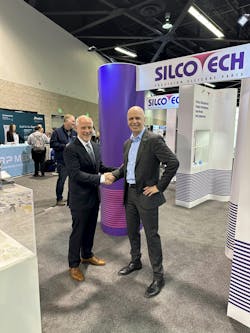Silcotech adds 2 new Arburg machines to meet growing demand for LSR medical parts
By Bruce Geiselman
Silcotech North America, a silicone parts molder, will buy two new Arburg injection molding machine work cells to meet the growing demand for liquid silicone rubber (LSR) medical devices.
Silcotech, headquartered in Bolton, Ontario, and Arburg announced the deal during the February Plastec West and MD&M West trade shows in Anaheim, Calif.
Silcotech’s business has grown 15 percent to 20 percent annually over the past two years, and the outlook is to keep that pace in fiscal year 2024 and beyond, said Dan Morris, Silcotech’s business development manager.
“We’re just generally increasing capacity as our business increases,” company President Michael Maloney said. “These additional lines are to satisfy the increasing demand. ... The majority of our business is in the medical device space, and it’s really the medical device space, primarily, that’s driving that demand.”
The two new Arburg machines are a 110-ton Allrounder 470 A 1000 – 290 Comfort and a 220-ton Allrounder 570 A 2000 – 400 Comfort. Both are all-electric machines specified with LIM/LSR molding options, as well as thermoplastic molding capabilities. Both will be equipped with Multilift Select 8 servo-electric robotics for parts removal and manipulation. Delivery is scheduled for this summer.
Silcotech bought its first LSR injection molding machines from Arburg 25 years ago when there were not many players in the LSR injection molding machine market, Maloney said.
“Our decision to move forward with Arburg was clearly based on our history of success using their machines,” he said. “Their machines feature a sound mechanical design coupled with a very progressive control system.”
Silcotech wants to maintain consistency in the brands of machinery it uses.
“It’s important not to have white elephants in a manufacturing environment,” Maloney said. “Consistency in control systems, machine behavior and robotic behavior is important for the facility to be efficient.”
LSR molding is particularly challenging and requires accurate, precise machinery because, in addition to the molding process, a chemical reaction is taking place.
“You have material that will begin to expand in the cavity and crosslink, and you have a chemical process superimposed over the molding process, and that adds a degree of complexity,” Morris said.
Silcotech expects its expansion to continue, Morris said.
“This is just the beginning,” Morris said. “We’re seeing more and more opportunities and requests to do multi-material applications with plastic and silicone. So, we’ve equipped these machines to be able to convert back and forth between plastic and silicone and accept our own in-house technology of second-, third-, and fourth-shot silicones.”
Contact:
Arburg Inc., Rocky Hill, Conn., 860-667-6500, www.arburg.com/en
About the Author
Bruce Geiselman
Senior Staff Reporter Bruce Geiselman covers extrusion, blow molding, additive manufacturing, automation and end markets including automotive and packaging. He also writes features, including In Other Words and Problem Solved, for Plastics Machinery & Manufacturing, Plastics Recycling and The Journal of Blow Molding. He has extensive experience in daily and magazine journalism.
